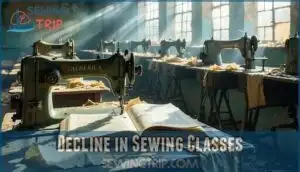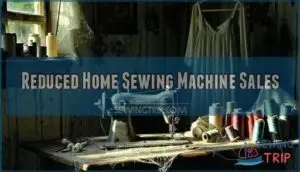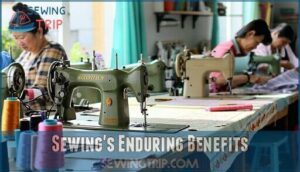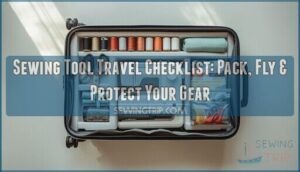This site is supported by our readers. We may earn a commission, at no cost to you, if you purchase through links.
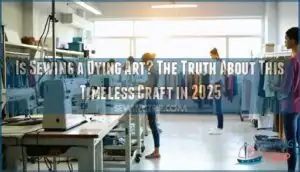
While traditional home sewing has taken a hit from fast fashion and fewer school programs, the craft isn’t dying—it’s evolving.
Social media has sparked a sewing renaissance, with millions sharing projects on Instagram and TikTok.
The sustainability movement‘s driving people back to their machines as they reject throwaway fashion.
Sure, you’ll find fewer sewing classes in schools, but online communities are picking up the slack.
Modern sewists blend vintage techniques with cutting-edge tools, creating everything from cosplay costumes to upcycled fashion.
The question isn’t whether sewing will survive, but how it’ll continue surprising us.
Table Of Contents
Key Takeaways
- You’ll find sewing isn’t dying but evolving slowly—while traditional home sewing and school programs have declined due to fast fashion, social media platforms like Instagram and TikTok are sparking a sewing renaissance among younger generations who value sustainability and creativity.
- You’re seeing a significant skill gap emerge as only 17% of high schools still offer textiles courses and sewing machine sales dropped 32% since 2015, creating shortages in skilled seamstresses and leaving alteration services struggling with massive backlogs.
- You can tap into sewing’s therapeutic benefits and cost-effectiveness—it provides stress relief, creative expression, and saves you 40-60% compared to ready-made clothing while allowing perfect customization and supporting environmental sustainability.
- You’ll discover exciting opportunities in modern sewing through digital patterns, online communities, virtual workshops, and e-commerce platforms like Etsy, where technology is breathing new life into traditional techniques and creating profitable ventures for skilled sewists.
Sewing’s Current State
You’ve probably noticed fewer people talking about sewing lately, and there’s a good reason for that.
The numbers tell a pretty stark story about what’s happening to this once-common household skill.
Decline in Sewing Classes
You’ve likely noticed fewer sewing classes around.
Enrollment dropped 30% since 2010, while only 17% of high schools still offer textiles courses.
Curriculum changes, teacher shortages, and funding cuts create a widening skill gap.
This generational shift toward digital learning leaves traditional sewing education struggling to survive in classrooms nationwide.
Adults can still learn fitting alterations techniques through specialized workshops, which helps to address the issue of traditional sewing education.
Reduced Home Sewing Machine Sales
Machine Innovation Lag tells the whole story behind sewing’s steep decline.
You’re witnessing a 32% drop in global home sewing machine shipments since 2015, while these key factors reshape the market:
- Sales Decline Reasons: 64% cite lack of time for home sewing
- Market Saturation: Only 14% of households bought machines recently
- Alternative Crafts: Younger generations choose different hobbies over sewing
Repair vs. Replace mentality hasn’t helped either.
Impact of Fast Fashion
Fast fashion’s $150 billion market floods stores with mass-produced clothing that’s worn just seven times before hitting landfills.
Fast fashion floods the market with disposable clothing worn just seven times.
This creates 92 million tonnes of textile pollution annually while teaching you that clothes are disposable.
When everything’s cheap and trendy, why learn sewing? Consumer habits shifted toward instant gratification over garment quality, making sustainable fashion and upcycling clothing seem outdated compared to quick retail fixes.
The industry contributes substantially to global carbon emissions, exacerbating environmental concerns and promoting a culture of fast fashion.
Is Sewing Dying
While the numbers paint a concerning picture, sewing isn’t exactly dying—it’s transforming. You’re witnessing a generational shift that’s reshaping how we think about this craft.
The statistics show a clear sewing decline, but they don’t tell the whole story about sewing’s relevance today. The data reveals some stark realities:
- Only 10% of people under 35 sew regularly as of 2025
- Home sewing machine sales dropped 25% worldwide over the past decade
- Sewing class enrollments fell by more than 30% from 2010 to 2024
- The average sewing guild member now exceeds 55 years old
However, younger generations are driving a quiet sewing resurgence through sustainability movements and social media platforms. Skill transmission is evolving from grandmother’s kitchen table to YouTube tutorials and online communities. The cultural impact remains strong, even if the methods have changed. Economic viability persists through indie pattern designers and ethical fashion movements, proving this craft’s adaptability.
Sewing’s Enduring Benefits
Despite declining participation rates, sewing continues offering unique benefits that modern life desperately needs.
You’ll find that this ancient craft provides therapeutic relief, creative expression, and practical advantages that mass-produced clothing simply can’t match.
Therapeutic and Creative Outlet
You’ll find peace threading your needle after stressful days.
Sewing becomes your personal retreat where creativity flows freely, letting you express yourself through fabric and thread.
This hands-on hobby builds confidence as you master new techniques, transforming simple materials into something uniquely yours.
The repetitive motions naturally calm your mind while nurturing your artistic spirit.
Customization and Cost-Effectiveness
Beyond the mental health benefits, sewing offers unmatched customization and cost-effectiveness that you simply can’t get with store-bought clothes.
When you master DIY clothing, you’re creating custom garments that fit your body perfectly—no more baggy shoulders or tight waistbands.
Consider these compelling financial advantages:
- Repair savings average $15-30 per garment versus replacement costs
- Alteration costs can be eliminated entirely through your own skills
- Unique fit means no expensive tailoring for body proportions
- DIY fashion costs 40-60% less than comparable quality ready-made pieces
- Handmade garments using quality fabric often outlast fast fashion by years
Sewing customization transforms your wardrobe into a reflection of your personal style while keeping more money in your pocket.
Many online resources promote affordable DIY projects.
Sustainability and Environmental Impact
When you sew, you’re fighting textile waste one stitch at a time.
The slow fashion movement champions sewing sustainability because homemade clothes last longer than fast fashion alternatives.
You’ll choose ethical fabric suppliers, repurpose materials creatively, and extend garment lifespan through repairs.
You can also minimize waste by employing zero-waste sewing practices.
This resourcefulness creativity reduces your environmental impact while building a wardrobe that truly reflects your values.
Challenges Facing Sewing
You can’t ignore the elephant in the room: sewing faces real challenges that threaten its future.
While the craft has survived centuries, modern pressures are creating obstacles that weren’t around when your grandmother first picked up a needle, posing a significant threat to its future.
Declining Number of Skilled Seamstresses
While alteration demand stays high, the sewing shortage grows worse each year.
You’ll find fewer skilled seamstresses available as garment workers retire faster than new talent enters.
The bridal crisis highlights this perfectly—wedding gown alterations face massive backlogs.
Elias Howe’s invention revolutionized garment production.
Without proper skill training programs, domestic talent can’t fill these gaps, leaving countless businesses struggling with labor shortage.
Immigration Policy Changes and Labor Shortage
You’re witnessing immigration policy shake up the sewing world.
Immigration restrictions are stitching together a labor crisis in America’s sewing industry.
Recent visa restrictions cut skilled textile workers by 15%, leaving garment factories scrambling.
Seamstress immigration dropped while alteration demand skyrocketed, creating a perfect storm.
The bridal crisis deepens as domestic talent can’t fill gaps left by fewer foreign workers entering the industry, causing a significant impact on the sewing world.
Lack of Sewing Education in Schools
You’ve probably noticed that home economics classes aren’t what they used to be.
Today’s educational landscape has systematically stripped sewing skills from school curricula, creating a massive skill gap that threatens future generations. This educational shift affects more than just classroom learning—it’s reshaping our relationship with handmade crafts.
Here’s what’s happening in schools today:
- 60% of high school home economics programs removed sewing from curricula since 2000—eliminating hands-on learning opportunities
- Sewing class enrollments dropped over 30% from 2010 to 2024—showing declining student interest and program availability
- Only 18% of U.S. high schools offered sewing classes in 2020—down from 70% in 2003
- Teacher training programs rarely include sewing education—leaving educators unprepared to pass on these traditional skills
Funding cuts hit sewing education programs particularly hard. Schools prioritize STEM subjects while viewing sewing as outdated, despite its problem-solving and creativity benefits. Without curriculum integration and proper teacher training, we’re losing the foundation that once guaranteed sewing skills passed naturally from generation to generation.
Sewing’s Future Prospects
Despite the challenges facing the sewing world, you’ll discover that this timeless craft isn’t disappearing—it’s evolving in exciting ways.
New technology, growing online communities, and a renewed focus on sustainability are giving sewing a fresh lease on life.
Modernizing The Craft With New Technology
Technology’s breathing new life into this ancient craft.
Digital patterns let you download designs instantly, while smart machines handle threading and tension automatically.
Online tutorials make learning accessible from your couch. You can even print custom fabrics at home and use virtual fitting apps to perfect your measurements before cutting.
Many sewists now purchase downloadable sewing templates for their projects, which involves using digital patterns and smart machines to create custom fabrics.
Opportunities for Online Selling and Community Building
Beyond Instagram’s feed of finished projects, you’re discovering entire ecosystems where sewing thrives digitally.
Digital patterns from indie designers flood your inbox while Virtual Workshops connect you with experts worldwide, breaking geographical barriers.
Top online opportunities transforming sewing:
- Etsy Sewing shops – Turn your creations into profitable ventures through handmade marketplaces
- Online Guilds – Join specialized communities for technique sharing and collaborative learning
- Fabric Sourcing platforms – Access global suppliers and unique materials previously unavailable locally
Sewing blogs showcase entrepreneurship success stories, while sewing Instagram builds followings that translate into business.
Many find success selling reusable snack packs, appealing to eco-conscious consumers.
The online community doesn’t just preserve this craft—it’s revolutionizing how we learn, share, and profit from our needle skills.
Preserving Traditional Techniques and Cultural Heritage
Heirloom sewing techniques aren’t just surviving—they’re thriving through passionate communities.
You’ll find textile history buffs preserving vintage patterns, while indigenous crafts gain new appreciation.
Regional styles that once seemed forgotten are finding fresh audiences through cultural heritage programs.
Museums, artisans, and sewing enthusiasts are working together to document sewing traditions, ensuring this rich sewing knowledge passes to future generations.
Exhibits like Sewn in America showcase this history.
Frequently Asked Questions (FAQs)
Is sewing becoming a lost art?
Like a once-vibrant tapestry gradually losing its threads, sewing isn’t dying—it’s transforming.
You’ll find fewer people learning traditional techniques, but passionate communities keep this craft alive through online tutorials and modern patterns, which helps sewing to stay alive.
Is tailoring a dying art?
Tailoring isn’t dying, but it’s definitely struggling. You’ll find fewer skilled tailors as older professionals retire and younger people don’t learn the trade, creating shortages in alterations and custom work.
When did sewing become less popular?
Picture threads unraveling from a once-tight fabric—sewing’s popularity began fraying in the 1980s.
You’ll find household participation dropped dramatically from 4% in 1985 to just 5% by 2020, as fast fashion swept traditional skills aside.
Is sewing making a comeback?
Sewing’s definitely experiencing a revival, especially among younger folks who value sustainability and creativity.
You’ll find thriving online communities, indie pattern designers, and renewed interest in DIY skills driving this resurgence forward.
What age should children start learning sewing?
Children can start learning basic sewing around ages 3-4 with simple hand stitching.
By ages 6-8, they’re ready for more structured lessons and basic machine work, fostering creativity and building foundational skills early.
How much do professional sewing lessons cost?
Don’t let sticker shock scare you away—professional sewing lessons range from $20-80 per hour depending on your instructor’s expertise and location, making this lifelong skill surprisingly affordable.
Which sewing machine brands are most reliable?
Brother, Janome, and Singer consistently top reliability rankings. You’ll find Brother offers great value, Janome excels in precision stitching, and Singer provides solid all-around performance that’s lasted generations.
Can sewing help with anxiety and depression?
Yes, you’ll find sewing incredibly therapeutic for managing anxiety and depression.
The repetitive motions create a meditative state, while completing projects boosts confidence and provides meaningful accomplishment that helps counter negative thoughts.
This process can lead to improved mental health by providing a sense of accomplishment.
What career opportunities exist in modern sewing?
You’ll discover diverse paths: design custom patterns, offer alterations, teach workshops, create sustainable fashion brands, provide costume services, or freelance for theaters.
The demand’s real, especially with today’s skilled seamstress shortage, which makes the field highly attractive for those looking to capitalize on the demand.
Conclusion
Don’t put all your eggs in one basket—sewing’s story isn’t over yet.
While asking "is sewing a dying art" reveals valid concerns about declining school programs and fast fashion’s dominance, you’re witnessing transformation, not death.
Modern sewists are weaving technology with tradition, creating sustainable alternatives to throwaway culture.
Online communities and social media have breathed new life into this ancient craft, proving adaptability trumps extinction.
Sewing’s future looks bright, stitched together by innovation and environmental consciousness.
- https://www.pdfplotting.com/
- https://www.uniformmarket.com/statistics/fast-fashion-statistics
- https://www.genevaenvironmentnetwork.org/resources/updates/sustainable-fashion/
- https://fashion.sustainability-directory.com/question/how-does-fast-fashion-impact-traditional-crafts/
- https://merl.reading.ac.uk/explore/online-exhibitions/fast-fashion-then-and-now/

